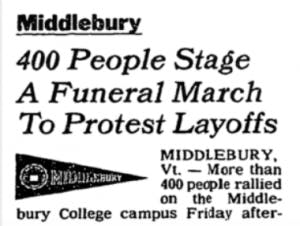The monthslong effort by Middlebury to shrink staff costs and reevaluate the way the institution does work is entering its most critical stage, and staff members report varying levels of satisfaction with the process as they wait for buyout offers to arrive in February.
The workforce planning process, announced by President Laurie L. Patton in a June email to college employees, began with the goal of shrinking staff compensation costs by 10 percent — about $8 million — by the end of the academic year. Now, administrators have reviewed proposals to reshape departments across the institution, and buyout offers will be sent to staff in early February. Involuntary layoffs remain a last resort, if not enough employees take buyouts by the end of the academic year.
Faculty, meanwhile, are undergoing a separate process of buyouts and retirement plans, as part of the same effort to reduce the college’s deficit.
LEARNING FROM THE PAST

For several years, college officials have been open about the financial challenges that the institution is facing, with yearly operating expenses exceeding revenues since the 2013 fiscal year. Causes of the deficit include rising financial aid commitments, a flawed policy that capped annual tuition increases and an aborted venture into online language instruction.
The college has since lowered its deficit faster than initially projected, hoping to balance its budget by fiscal year 2021. But faculty and staff pay remains the institution’s biggest expense, often making up about two-thirds of its annual spending.
This is not the first time that budgetary issues have prompted the college to rein in staff costs, and administrators are taking lessons from past mistakes. In 1991, college officials, led by then-President Timothy Light, abruptly fired 17 staff members, causing an uproar that made national news and brought about Light’s resignation. And following the 2008-09 financial crisis, the college offered voluntary buyouts to any employee interested in taking one — an unstructured process that led to excessive loss of crucial staff positions, some of which needed to be restaffed shortly afterwards.
So when administrators realized a new wave of deficit reductions were needed, they took a more deliberate approach. “To do it in a really thoughtful way we needed to think about the work we do, and how we could staff ourselves for a sustainable future,” said Bill Burger, vice president of communications and chief marketing officer.
Beginning in the early fall, staff vice presidents across the institution were tasked with leading discussions within their departments about how their work could be redesigned, and done more efficiently. In December, each department submitted two different proposals to senior leadership, containing alternate plans that would cut compensation by 10 and 15 percent, respectively.
Now, staff across Middlebury can only wait. As of last week, Burger said, senior leadership was almost done reviewing the proposals and finalizing a list of positions to be cut. Before decisions are finalized, Human Resources is required by law to review the proposals to make sure they do not disproportionately affect certain demographics.
In early February, staff working in areas where the college plans to cut positions will get letters giving them the option to apply for buyouts. The college will send more applications than necessary, anticipating that many will decline to apply. By early March, the applications will be due and administrators will know whether enough staff have volunteered to take the buyouts, or whether they will need to resort to layoffs. On the other hand, if more staff than necessary apply, the most senior staff will be offered buyouts first.
The staff cuts in some areas will be partially offset by the creation of about 40 new staff positions in other areas — the result of new needs identified through the planning process. Applications for these positions will first be made available in early February to all staff members who are offered buyouts.
WAITING FOR WORD

David Kloepfer, assistant director of student activities, said he is satisfied with how the process has been communicated in his department.
Workforce planning will have uneven effects across Middlebury, leaving some staff departments largely intact while transforming others. Likewise, staff contacted by The Campus report uneven feelings about the process. Many said they have been pleased with the level of transparency thus far, while some complain that the drawn-out process has left them on edge for too long. Others say they simply haven’t paid much attention to it all.
“For our area, the communication’s been really great,” said David Kloepfer, the assistant director of Student Activities. “We haven’t heard exactly what the full plan is as of yet. We’re still waiting to hear the final outcome.”
Missey Thompson, box office coordinator at the Mahaney Center for the Arts and a representative of the staff council, said workforce planning has been a major point of conversation at the council’s meetings for some time. The staff council advocates for good working conditions for college employees and has held forums and posted information about workforce planning on its blog since the process was announced.
“We knew that something was coming a while ago — we didn’t know what it all entailed until they were ready to tell us,” she said, adding that some anxiety remains about the potential job cuts. “Whenever people have to leave, it can cause a lot of tension, but I think it depends on the day and how people feel so we’re just kind of going with the flow. That’s all we can do right now.”
[pullquote speaker="" photo="" align="center" background="on" border="all" shadow="on"]You might lose the 40 percent of your job that you like.[/pullquote]
But some staff who feel most at risk of losing their jobs say that the long process has been a source of deep stress. Academic coordinators, who handle the logistics of academic departments and support faculty and student work, fear that some of their positions may be cut, while the coordinators who stay employed will need to deal with new responsibilities.
“Morale is terrible,” said Judy Olinick, coordinator for the Russian, German and Japanese Departments. “Everybody is worried about it, it’s just been going on so long.”
While Olinick, like other staff, participated in the initial planning conversations this fall, she reported feeling helpless as the final say was left to senior leadership.
“We had all these meetings where we discussed it at great lengths, breaking up into little groups — ‘What can you change, and how would you change it?’” she said. “But it doesn’t mean anything unless you have some idea of what is really going to be changed.”
Even staff who expect to keep their jobs face uncertainty about how much their job descriptions will be changed, according to Tim Parsons, landscape horticulturist and president of staff council. An employee who gets to keep 60 percent of their job tasks, for example, may still be disappointed by the results of workforce planning.
“You might lose the 40 percent of your job that you like,” Parsons said.
Still, some staff look forward to the impending changes to their departments.
“I’m looking forward to some changes, to stir things up,” said Christina Richmond, an Atwater Dining Hall I.D. checker and servery worker. “Change is always good. I’m not afraid of it.”
GROWING PAINS

The Envisioning Middlebury framework, pictured on the college's website. Some staff said that they were unable to plan for the future while remaining uncertain how their jobs would change in the short term.
Multiple staff members reported frustration about the way workforce planning has become intermingled with the goals of Envisioning Middlebury, the college’s long-term strategic framework. Patton herself connected the two processes in her June message, saying that they both entail “responsible stewardship of our resources.”
Dan Frostman, manager of the Davis Family Library circulation desk, said that the alignment of the two processes made decision-making difficult.
“We were trying to envision the next five to 10 years while also trying to figure out what it would look like if we got rid of 10 percent of the staff,” he said, noting that he reached out to his circulation staff to get input on both the changes they wanted to see and the cuts that had to be made. “So that was challenging and, personally, a little bit frustrating, to try to do those two sort of opposed things at the same time. There wasn’t a lot of reconciling that could be done between the two.”
Olinick said that she and her colleagues struggled to focus on the future, since workforce planning presented a more immediate issue.
“How can you make recommendations about that if you’re worried about keeping your job?” she said.
BEYOND WORKFORCE PLANNING
Workforce planning is not the only source of staff discontent at Middlebury. Low salaries in certain staff positions have prompted some employees to seek work elsewhere, and a 2017 staff survey showed low confidence in senior leadership and dissatisfaction with the way administrative decisions are communicated.
But Burger said that those concerns have informed this process, prompting administrators to focus on communication and consider changing the compensation structure once the planning is complete.
Though administrators expect to resolve the institution’s budget shortfalls within the next few years, the college remains heavily staffed, with a growing student body. With the newly-completed Envisioning Middlebury project serving as a likely precursor to a major fundraising campaign, this may not be the last time the college has to reconcile its long-term goals with its short-term needs.
For full staff issue coverage, click here.
Correction: An earlier version of this article said that the new positions created by the planning process will first be made available to staff members who took buyouts, when they will actually first be available to all staff members who were offered buyouts.
Staff Cuts Loom as Workforce Planning Hits Critical Stage

MICHAEL BORENSTEIN, NICK GARBER, SABINE POUX/THE MIDDLEBURY CAMPUS
L-R: Economics department coordinator Amy Holbrook, Facilities worker Nick Boise, Atwater I.D. checker and servery worker Christina Richmond.
L-R: Economics department coordinator Amy Holbrook, Facilities worker Nick Boise, Atwater I.D. checker and servery worker Christina Richmond.
In 1991, the New York Times reported on Middlebury's abrupt firing of 17 staff members, which prompted protest and brought about the resignation of the college president, Timothy Light.
SABINE POUX/THE MIDDLEBURY CAMPUS
MIDDLEBURY COLLEGE
Comments



